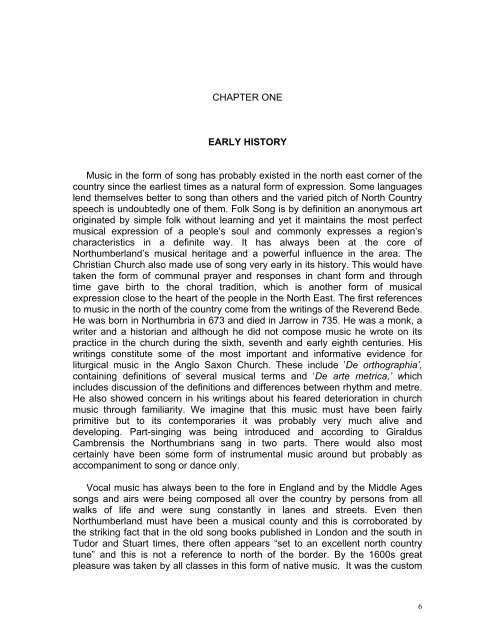NEWCASTLE'S MUSICAL HERITAGE AN INTRODUCTION By ...
NEWCASTLE'S MUSICAL HERITAGE AN INTRODUCTION By ...
NEWCASTLE'S MUSICAL HERITAGE AN INTRODUCTION By ...
You also want an ePaper? Increase the reach of your titles
YUMPU automatically turns print PDFs into web optimized ePapers that Google loves.
CHAPTER ONE<br />
EARLY HISTORY<br />
Music in the form of song has probably existed in the north east corner of the<br />
country since the earliest times as a natural form of expression. Some languages<br />
lend themselves better to song than others and the varied pitch of North Country<br />
speech is undoubtedly one of them. Folk Song is by definition an anonymous art<br />
originated by simple folk without learning and yet it maintains the most perfect<br />
musical expression of a people’s soul and commonly expresses a region’s<br />
characteristics in a definite way. It has always been at the core of<br />
Northumberland’s musical heritage and a powerful influence in the area. The<br />
Christian Church also made use of song very early in its history. This would have<br />
taken the form of communal prayer and responses in chant form and through<br />
time gave birth to the choral tradition, which is another form of musical<br />
expression close to the heart of the people in the North East. The first references<br />
to music in the north of the country come from the writings of the Reverend Bede.<br />
He was born in Northumbria in 673 and died in Jarrow in 735. He was a monk, a<br />
writer and a historian and although he did not compose music he wrote on its<br />
practice in the church during the sixth, seventh and early eighth centuries. His<br />
writings constitute some of the most important and informative evidence for<br />
liturgical music in the Anglo Saxon Church. These include ’De orthographia’,<br />
containing definitions of several musical terms and ‘De arte metrica,’ which<br />
includes discussion of the definitions and differences between rhythm and metre.<br />
He also showed concern in his writings about his feared deterioration in church<br />
music through familiarity. We imagine that this music must have been fairly<br />
primitive but to its contemporaries it was probably very much alive and<br />
developing. Part-singing was being introduced and according to Giraldus<br />
Cambrensis the Northumbrians sang in two parts. There would also most<br />
certainly have been some form of instrumental music around but probably as<br />
accompaniment to song or dance only.<br />
Vocal music has always been to the fore in England and by the Middle Ages<br />
songs and airs were being composed all over the country by persons from all<br />
walks of life and were sung constantly in lanes and streets. Even then<br />
Northumberland must have been a musical county and this is corroborated by<br />
the striking fact that in the old song books published in London and the south in<br />
Tudor and Stuart times, there often appears “set to an excellent north country<br />
tune” and this is not a reference to north of the border. <strong>By</strong> the 1600s great<br />
pleasure was taken by all classes in this form of native music. It was the custom<br />
6

















